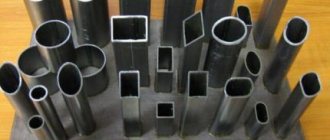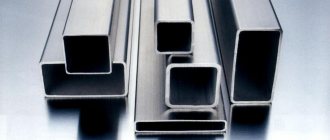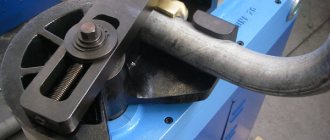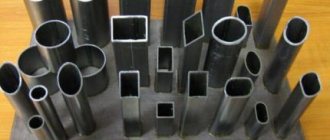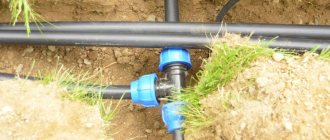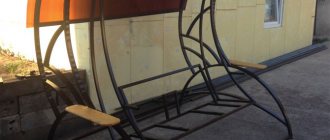When installing water supply and sewerage systems made of polyethylene, sometimes it becomes necessary to go around an obstacle and change the direction of laying the pipeline. If there are no suitable fittings at hand, and also to reduce the cost of work, the question arises - how to bend a HDPE pipe and whether it is possible to carry out such an operation at all. It is quite possible. Next, we will consider a number of ways to give a pipe the desired bend angle yourself or in a production environment.
Features of low pressure polyethylene pipes
Pipes made of low-density polyethylene (HDPE or HDPE according to the international classification) are increasingly replacing metal pipes from use in construction.
Bend angle
45 degree bend
The sensitivity of the material to heat, its elasticity and lightness make it possible to create blanks from HDPE pipes in order to change the direction of the laid pipeline and go around obstacles.
It should be taken into account that the bending angle should not exceed 90°.
Angles of 30, 45, 60, 90 degrees are considered standard.
Melting temperature
When molding polyethylene pipe products, it is necessary to take into account the temperature characteristics of the material. Its softening begins at a temperature of +80Сo, and melting occurs from +130Со to +137С о. It is at this temperature that HDPE pipes are produced.
Calculation of a very small diameter for a given length
For approximate calculations of the bending radius, you will need two rigid rulers of 30 and 50 cm in length (their choice depends on the magnitude of the bend). The procedure looks like this:
- First of all, the bend radius of the already formed pipe is measured, which must be copied onto the original workpiece.
- When measuring a strong bend, take a 30 cm ruler and apply it to the ends of the curved pipe, after which the distance between it and the middle of the workpiece is measured.
- For a small bend (longer pipe length), the same operations are performed with a 50 cm ruler, as shown in the photo below.
Retrieving data for calculation
A – interval (clearance), mm.
D – arc diameter, mm.
R is the radius to which it is planned to bend the pipe, mm.
To understand what the required parameter R is, you need to look at the photo published below in the text, which shows a sample of an already bent workpiece.
Based on the data obtained during measurements, it is then necessary to select a suitable indicator of the radius (diameter) of the arc, the values of which can be found in the prepared tables. They are located in sources on the World Wide Web (where different options for preliminary measurements are taken into account).
Bending methods
HDPE is both a very durable and flexible material. This allows you to heat the workpiece to a softened state, and then bend the pipe, giving it the required bend angle.
Production
Molding machine
For this purpose, special molding industrial equipment is used - high-precision molding machines.
Achieving a specific bend radius is calculated based on the ratio of the cross section to the outer diameter.
This is done in two ways:
- rolling a roller around a template with a given bending radius without filler;
- screwing onto a bending template using a mandrel inside that protects against damage.
Household
If it is impossible to use molding machines to bend HDPE pipes, less precise methods are used, based on the use of available equipment or improvised means for heating. The bending of the pipe, as in the industrial method, is carried out by forming a given angle according to a pre-made bending template
Using a hair dryer
A safe and effective method for doing the job at home. It is important to have a hair dryer of sufficient power with precise adjustment of the operating temperature.
Operating principle:
- heating the bending area,
- forming (bending) the workpiece according to the template.
At a low operating temperature or a significant distance between the hair dryer and the surface of the material, the softening of the polymer will be insufficient, so there is a high risk that the pipe wall will deform or crack when bending.
Using a gas burner
According to the principle of operation, the method is an alternative to using an electric hair dryer. But this option is significantly inferior to the previous one in terms of safety: experience with such equipment is required.
If the burner is close to the polyethylene, it may melt or ignite.
The advantage is the possibility of use in places where there is no power supply, as well as the lower cost of purchasing a 200 ml cylinder for a gas burner (compared to a medium-power construction hair dryer).
Hot water treatment
The simplest, but ineffective method in the absence of a hair dryer or gas burner. At home, using hot water it is quite difficult to evenly heat the wall thickness, as well as the surface area required for bending. If the amount of work is small and the pipe diameter is no more than 50 mm, it is quite possible to use a regular kettle.
Hot water can be replaced with bulk materials, such as salt or river sand. It is necessary to heat them to the desired temperature, for example in a frying pan or baking sheet, pour them into the pipe and wait for the product to heat up. After this, carefully bend and let cool.
What type of heating tool should be used?
Polyethylene is a capricious material; to bend it, it is better to take high-quality equipment, otherwise there is a risk of quickly replacing the pipe with a new one. Therefore, when choosing heating equipment, pay attention to the following:
- There must be excellent temperature control so that you can control the heating level; there must be air flow adjustment; it is desirable to have several modes. If you are not sure which one to work on, it is best to test it first on a small piece of pipe, which you can then throw away; the kit should include nozzles for gluing the pipe.
Bending the pipe with your hands is impossible, so don’t try to do it this way, you’ll just damage it and that’s it.
If you do not have the opportunity to purchase heating equipment, then first think about where and how the pipe should go during installation, and when purchasing it, simply ask the seller to perform such a service. Usually there is no problem here; the cost of such bending is quite low. But if you are laying pipes, for example, in a country house, then a gas burner or a hair dryer will not be superfluous in your household, so it is better to purchase them right away, they will be needed not only when bending the water supply, but also when performing other work.
Share a useful article:
Related Articles: Featured Articles
Bending HDPE pipes at home
Before starting work, prepare:
- fibreboard (fibreboard) or board for making your own bending template;
- the pipe that you will bend;
- a tool available to you for heating the workpiece (gas burner, hair dryer or container of hot water).
Safety regulations
Work at home without following safety regulations can lead to burns of varying severity and even fire.
- Choose a place to work away from flammable objects.
- When working with heating devices, use protective clothing and gloves.
- Stay at a sufficient distance for your safety from the open flame of a gas burner.
Stages of work execution
- Carry out an accurate calculation of the bending radius of the HDPE workpiece for the pipeline. Please note that the bend angles are not
180 degree bend on a wooden templatemust exceed 90 degrees to avoid pipe deformation during operation.
- Based on the calculation, make a template from a fiberboard slab with the required bending radius and shape.
- Mark the area to be heated. If a pipe bend of 90 degrees is required, it is recommended to heat a section whose length will be six of its diameters.
- Direct the heat flow from a hair dryer or the flame of a gas burner to the marked place. For ease of operation, you can mount the heating device on a fixed support. When using hot water to heat a product at this stage, lower a section of pipe into a container of liquid.
- Try to smoothly and slowly rotate the workpiece around its axis to evenly heat the bending area. The required heating temperature is from +80 to +120 degrees.
- Place the softened workpiece in a pre-prepared bending template and slowly bend it at the required angle.
- Carefully ensure that the material does not begin to harden; reheat if necessary.
- Leave the bent pipe to cool on the template.
- It is possible to begin assembling the workpiece only after the product has completely cooled.
Bend a pipe using a forming machine
To do this, you must first prepare a frame that will protect the workpiece from damage. It is made from fiberboard, taking into account the diameter of the bent pipe.
Bend a HDPE pipe using a forming machine
Further operations are performed in the following sequence:
- A silicone shell is made;
- A pipe is inserted into it and secured in a pre-made fiberboard frame;
- The entire structure is fixed in the molding unit;
- Heating the polymer product and performing bending;
- Cooling the workpiece.
It is very important that the surface of the frame does not have any unevenness or other defects; for this it must be well sanded using sandpaper.
Possible mistakes
If the technology for bending polyethylene pipes is violated, the result may be damaged material, as well as the inability to use blanks in pipeline installation.
- When bending a pipe without using a bending template, it is impossible to achieve the exact angle of the finished product.
- Bending a pipe that is not sufficiently heated to the required temperature range leads to a high risk of cracks appearing in the material (the minimum temperature at which HDPE becomes plastic is + 80 degrees).
- If the heating exceeds +130 degrees, deformation is possible: this is the temperature at which polyethylene begins to melt.
- If you ignore the uniform rotation of the workpiece around its axis, the wall may break when it is bent (not the entire area required for bending is heated).
- Removing a workpiece from the molding template that has not completely cooled will lead to deformation of the product and a change in the specified bend angle, which will make accurate assembly of the pipeline impossible.
When independently performing work on bending HDPE pipes, take into account the characteristics of the material and the technological features of the process of forming the workpiece, and observe safety precautions. This will help you save your time and money.
Briefly about the main thing
Polyethylene pipes are an ideal material for installing outdoor water supply systems. They are inexpensive, easy to assemble using clamp fittings, and are not afraid of water freezing inside. The only inconvenience is the need to straighten the coiled pipes. But this is not a big problem, since polyethylene is a thermoplastic material and easily takes the desired shape when heated under the sun, when blown with hot air or when hot water or sand is placed inside the pipe.
Question
Write in the comments what would you prefer - quick straightening of pipes with a gas torch or a long, but less dangerous process of filling them with hot water (sand)?

